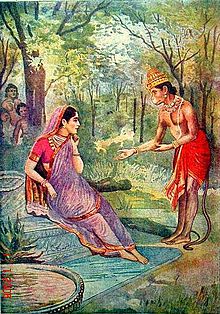Overview
Introduction to Sunderkand
Sunderkand is an integral part of the Hindu epic Ramayana, composed by the sage Valmiki. It is a chapter that focuses on the adventures of Hanuman, the monkey god, as he embarks on a journey to find Sita, Lord Rama’s wife, who has been abducted by the demon king Ravana. Sunderkand holds immense significance in Hindu mythology and is revered for its profound teachings and spiritual insights. This chapter serves as a source of inspiration and guidance for devotees, teaching them about devotion, courage, and unwavering faith. The story of Sunderkand is filled with extraordinary events and showcases the extraordinary powers of Hanuman. It highlights the importance of loyalty, determination, and selflessness. Sunderkand is a timeless tale that continues to captivate readers and is considered a sacred text in Hinduism.
Historical background
The historical background of Sunderkand is rooted in ancient Indian mythology. It is a chapter from the epic Ramayana, which is one of the most revered texts in Hinduism. The Ramayana tells the story of Lord Rama, the seventh avatar of Lord Vishnu, and his journey to rescue his wife Sita from the demon king Ravana. Sunderkand specifically focuses on the events that unfold when Lord Hanuman, the monkey god and devotee of Lord Rama, crosses the ocean to reach Lanka, the kingdom of Ravana. This chapter is considered to be highly significant as it showcases the unwavering devotion and determination of Lord Hanuman, and highlights the power of faith and the triumph of good over evil.
Importance in Hindu mythology
The Significance of Sunderkand in Hindu mythology cannot be overstated. Sunderkand is a chapter from the Indian epic Ramayana, which narrates the journey of Lord Hanuman to find and deliver a message to Lord Rama’s wife, Sita, who was held captive by the demon king Ravana. It is considered one of the most important chapters in the Ramayana and holds immense religious and spiritual significance. The word ‘Sunderkand’ itself means ‘beautiful chapter’ and is believed to bring immense blessings and divine grace to those who recite it with devotion. It is said to have the power to remove obstacles, bestow courage, and bring peace and prosperity to the devotees. The recitation of Sunderkand is often performed in temples, homes, and during religious ceremonies as a way to seek the blessings of Lord Hanuman and invoke his protection and guidance.
The Story of Sunderkand

Summary of the events
The Significance of Sunderkand: Deep Dive into Eternity is an article that explores the importance and meaning of the ancient Hindu scripture, Sunderkand. Sunderkand is a chapter in the Indian epic, Ramayana, which narrates the journey of Lord Hanuman to find and rescue Lord Rama’s wife, Sita, who has been abducted by the demon king, Ravana. The chapter is filled with multiple significant events, each carrying its own message and teachings. In this section, we will provide a summary of the events that occur in Sunderkand.
Key characters
Sunderkand, an integral part of the Indian epic Ramayana, showcases the bravery and devotion of Lord Hanuman. This chapter holds immense significance in Hindu mythology as it revolves around the journey of Lord Hanuman to Lanka in search of Sita, the wife of Lord Rama. Key characters in Sunderkand include Lord Rama, Sita, Lord Hanuman, and Ravana. Discovering the miracles of Sunderkand and experiencing Lord Hanuman’s grace are central themes in this epic tale. Lord Hanuman’s unwavering loyalty and his extraordinary powers are highlighted throughout the narrative, making him a symbol of strength and devotion. This chapter serves as a reminder of the power of faith and the triumph of good over evil.
Symbolism and deeper meanings
The Significance of Sunderkand: Deep Dive into Eternity
Symbolism and deeper meanings
Sunderkand, a chapter from the ancient Indian epic Ramayana, holds immense symbolism and deeper meanings. It is a profound exploration of devotion, courage, and determination. Sunderkand is considered a spiritual journey that reflects the eternal bond between Lord Hanuman and Lord Ram. The chapter showcases the unwavering loyalty, selflessness, and strength of Hanuman, who embarks on a mission to find Sita, Lord Ram’s wife, who has been abducted by the demon king Ravana. Sunderkand is also believed to bring peace, prosperity, and protection to those who recite it with faith and devotion. According to Wikipedia, Sunderkand is one of the most revered chapters of Ramayana, and its recitation is considered auspicious and beneficial.
Spiritual Significance

Devotion and faith
Devotion and faith are essential aspects of the human experience. They provide individuals with a sense of purpose and connection to something greater than themselves. In the search for wisdom, devotion and faith play a crucial role. They guide individuals towards a deeper understanding of the world and their place in it. Through devotion, one learns to trust in a higher power and surrender to its will. This surrender leads to a profound sense of peace and clarity, allowing individuals to tap into their inner wisdom. Faith, on the other hand, fuels the fire of determination and perseverance. It gives individuals the strength to overcome obstacles and pursue their goals with unwavering conviction. In the realm of spirituality, devotion and faith are inseparable companions on the journey towards enlightenment. They provide the foundation upon which wisdom can be built and nourished.
Power of Hanuman
The power of Hanuman is unmatched and unparalleled. Hanuman, also known as the monkey god, is revered for his immense strength, wisdom, and devotion. He is a central character in the Hindu epic Ramayana and is considered to be an embodiment of loyalty and courage. Hanuman’s devotion to Lord Rama is legendary, and his unwavering support and assistance played a crucial role in the victory of good over evil. His ability to fly, change his size, and possess supernatural powers further adds to his mystique. Hanuman’s influence extends beyond religious boundaries, and he is worshipped by millions of people around the world. His stories and teachings continue to inspire and empower individuals to overcome obstacles and achieve greatness. The power of Hanuman is not just a myth or legend; it is a force that resonates with believers and seekers of truth.
Lessons for life
The Significance of Sunderkand: Deep Dive into Eternity
Lessons for life
Sunderkand, a chapter from the epic Ramayana, holds immense significance in Hindu mythology. It is a tale of devotion, courage, and determination. One of the key lessons that can be learned from Sunderkand is the unwavering devotion of Hanuman towards Lord Rama. Hanuman, the monkey god, is depicted as the epitome of loyalty and selflessness. His actions and sacrifices in his quest to find Sita, Lord Rama’s wife, serve as an inspiration for all of us. Hanuman’s unwavering devotion teaches us the importance of faith and the power of selfless service. Through his actions, Hanuman reminds us that with unwavering devotion and determination, we can overcome any obstacle and achieve our goals.
Impact on Society

Cultural influence
The Sunderkand, a chapter from the epic Ramayana, holds immense cultural significance in Hinduism. It narrates the heroic journey of Lord Hanuman, the monkey god, to find and rescue Sita, the wife of Lord Rama, who has been kidnapped by the demon king Ravana. The story of Sunderkand is not only revered for its religious importance but also for its moral and spiritual teachings. It highlights the virtues of devotion, courage, loyalty, and selflessness. The recitation of Sunderkand is believed to bring prosperity, peace, and protection from evil. Hanuman, the central figure of Sunderkand, is worshipped as a symbol of strength, wisdom, and devotion. The influence of Sunderkand can be seen in various aspects of Hindu culture, including music, dance, art, and literature. It continues to be recited, studied, and celebrated by millions of devotees around the world.
Religious practices
Religious practices hold a significant place in the lives of people across different cultures and belief systems. One such practice that has gained immense popularity is the Paath of Sunderkand. The word ‘Paath’ refers to the recitation or reading of religious texts, and Sunderkand is a chapter from the epic Ramayana. This sacred practice involves reciting the verses of Sunderkand, which is believed to bring blessings, protection, and spiritual upliftment to the devotee. The Paath of Sunderkand is often performed in groups or individually, with devotees immersing themselves in the divine narrative of Lord Hanuman‘s journey to find Sita, the wife of Lord Rama. The recitation of Sunderkand is considered a powerful way to seek divine intervention, overcome obstacles, and attain inner peace. It serves as a reminder of the importance of faith, devotion, and perseverance in one’s spiritual journey.
Inspiration for art and literature
The Significance of Sunderkand: Deep Dive into Eternity
Inspiration for art and literature
The Sunderkand, a chapter from the Indian epic Ramayana, has been a constant source of inspiration for art and literature. It depicts the journey of Lord Hanuman to Lanka in search of Sita, the wife of Lord Rama. This chapter is filled with powerful and emotional moments that have captivated the hearts of artists and writers for centuries. The vivid descriptions of Hanuman’s courage, devotion, and determination have been portrayed in various forms of art, including paintings, sculptures, and literature. The Sunderkand has also served as a muse for poets, who have beautifully captured its essence in their verses. The timeless tale of love, loyalty, and righteousness depicted in the Sunderkand continues to inspire artists and writers to create masterpieces that resonate with audiences across generations.
Sunderkand and Meditation

Meditative qualities
Meditative qualities:
Sunderkand, a chapter from the epic Ramayana, holds immense significance in Hindu mythology. It is known for its meditative qualities, providing solace and inner peace to those who recite it. The soothing verses and rhythmic chants transport the mind to a state of tranquility, allowing one to connect with the divine. Sunderkand is often recited as a form of prayer or meditation, with devotees finding solace in its melodic recitation. The profound impact of Sunderkand on the spiritual journey of individuals cannot be understated.
Chanting and recitation
Chanting and recitation play a pivotal role in the practice of Sunderkand. The act of chanting the sacred verses and reciting the divine hymns is believed to create a powerful spiritual connection with Lord Hanuman. The devotees embrace the sacredness of this practice, as it allows them to immerse themselves in the divine energy and experience a profound sense of peace and tranquility. The rhythmic repetition of the verses not only helps in focusing the mind but also invokes a deep sense of devotion and reverence. By chanting and reciting Sunderkand, one can embark on a spiritual journey that transcends time and space, leading to a deeper understanding of oneself and a closer connection with the divine.
Connecting with the divine
Connecting with the divine is a profound experience that transcends the boundaries of our physical existence. It is a spiritual journey that allows us to establish a deep connection with the divine energy that permeates the universe. Sunderkand, a chapter from the ancient Indian epic Ramayana, holds immense significance in this regard. It serves as a powerful tool for connecting with the divine and experiencing a sense of oneness with the higher power. Sunderkand narrates the heroic journey of Lord Hanuman as he embarks on a mission to find and rescue Lord Rama’s wife, Sita, who has been abducted by the demon king Ravana. The chapter is filled with captivating incidents and teachings that inspire and uplift the human spirit. Through the recitation and contemplation of Sunderkand, devotees can tap into the divine energy and seek guidance, protection, and blessings from the divine. The verses and passages that highlight the courage, devotion, and unwavering faith of Lord Hanuman can be particularly emphasized, as they showcase the essence of connecting with the divine in the face of adversity.
Modern Relevance

Relevance in today’s world
The Sunderkand, a chapter from the epic Ramayana, holds immense significance in today’s world. It serves as a guiding light, offering valuable lessons and insights that are applicable even in the modern era. The timeless teachings of Lord Hanuman’s journey to find Sita, the wife of Lord Rama, resonate with people from all walks of life. The unwavering devotion, courage, and determination displayed by Hanuman in his quest inspire individuals to overcome obstacles and face challenges with unwavering faith. The Sunderkand teaches us the importance of loyalty, selflessness, and the power of good over evil. It reminds us that no matter how difficult the circumstances may be, with faith and perseverance, we can triumph over any adversity. In a world filled with chaos and uncertainty, the Sunderkand provides solace and hope, reminding us of the eternal values that can guide us towards a meaningful and purposeful life.
Sunderkand in popular culture
Sunderkand is an epic chapter of the Indian epic Ramayana. It holds immense significance in Hindu mythology and is considered a sacred text. The story revolves around the journey of Lord Hanuman to Lanka in search of Sita, the wife of Lord Rama, who had been kidnapped by the demon king Ravana. Sunderkand has not only been a part of religious rituals and ceremonies but has also found its place in popular culture. It has been adapted into various forms of art, including music, dance, and theater. The popularity of Sunderkand can be attributed to its timeless themes of devotion, courage, and righteousness, which resonate with people across generations. It continues to inspire and captivate audiences, making it an integral part of the cultural fabric of India.
Continued devotion and worship
Continued devotion and worship are essential aspects of the practice of Sunderkand. This ancient Hindu scripture holds immense significance in the hearts of devotees, as it narrates the heroic journey of Lord Hanuman to find and rescue Goddess Sita, the wife of Lord Rama. The devotion and worship of Sunderkand are believed to bring blessings, protection, and spiritual growth to the devotees. It is a powerful means of connecting with the divine and seeking guidance and strength in times of need. The continuous recitation and contemplation of Sunderkand instill a sense of deep faith and devotion, fostering a closer relationship with Lord Hanuman and the divine forces. The practice of Sunderkand is not only an act of devotion but also a way to attain peace, harmony, and enlightenment in one’s life. By immersing oneself in the verses and teachings of Sunderkand, devotees find solace, inspiration, and a renewed sense of purpose in their spiritual journey.
Author Profile

Latest entries
- 28 June 2025BlogHow to Choose the Best High-Yield Savings Account with 5%+ Interest in India (2025 Guide)
- 28 December 2024BlogTop 6 Employee Management Software for Small Businesses
- 19 December 2024BlogShri Hanuman Chalisa in Hindi Text with English Translation
- 7 August 2024BlogTop 13 Online Master of Social Work Programs

